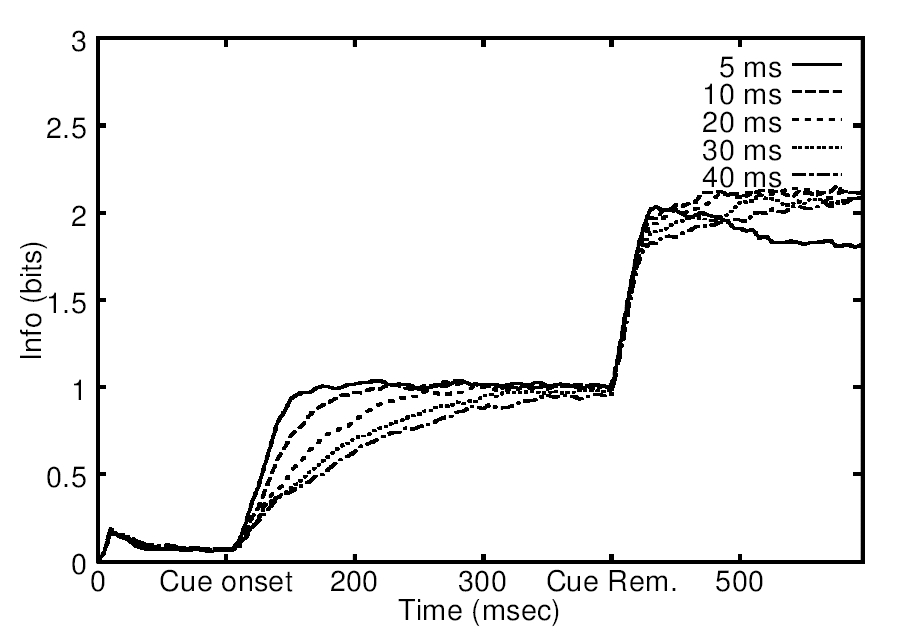LIMBO: Dynamics
 The aim
is to understand the origin of the
time scales for neural
information representation and processing, and to relate them to
underlying
biophysical parameters [3] and to experimental observations [2].
Following the original analysis [1] which
linked
the most important of these time scales to synaptic conductance
inactivation
times, extensive simulations needed to be carried out to validate and
extend
theoretical results [4]. These have revealed a conflict between
dynamical
stability and memory capacity, which is avoided only if inhibition is
of a
sufficiently multiplicative nature [5]. Moreover the time for
collective
information retrieval has been confirmed, but only when mean-field
dynamics
prevails, to be linearly related to synaptic conductance inactivation
times,
and only weakly dependent on firing rates and membrane time constants
[6]. The
applicability of the mean-field approximation is limited, as evident
from the
picture: at (partial) cue onset the network slowly enters the correct
basin of
attraction, with slow mean-field dynamics paced by synaptic
inactivation,
whereas at cue removal the network abruptly jumps to the recurrent
attractor state
(in this case much more correlated to the memory than the partial cue),
with a
rapid transition that mean-field cannot describe.
The aim
is to understand the origin of the
time scales for neural
information representation and processing, and to relate them to
underlying
biophysical parameters [3] and to experimental observations [2].
Following the original analysis [1] which
linked
the most important of these time scales to synaptic conductance
inactivation
times, extensive simulations needed to be carried out to validate and
extend
theoretical results [4]. These have revealed a conflict between
dynamical
stability and memory capacity, which is avoided only if inhibition is
of a
sufficiently multiplicative nature [5]. Moreover the time for
collective
information retrieval has been confirmed, but only when mean-field
dynamics
prevails, to be linearly related to synaptic conductance inactivation
times,
and only weakly dependent on firing rates and membrane time constants
[6]. The
applicability of the mean-field approximation is limited, as evident
from the
picture: at (partial) cue onset the network slowly enters the correct
basin of
attraction, with slow mean-field dynamics paced by synaptic
inactivation,
whereas at cue removal the network abruptly jumps to the recurrent
attractor state
(in this case much more correlated to the memory than the partial cue),
with a
rapid transition that mean-field cannot describe. While
simulations use simplified stimuli with instantaneous onset, data
recorded from
IT neurons has indicated what are the relevant
time scales
with natural visual stimuli [6]. The simple S+F model used to
describe
spike counts can be used as a basis for to model the effects of
associative
plasticity on feed-forward synapses [7].
A collaboration with Marco Canepari has focused instead on single synapses with highly stochastic release, relating the time for effective integration of presynaptic spike trains to quantal parameters and their modulation [8].
Two more recent lines of research involve convergent dynamics in IT (AAA, AT, see cortical attractors) and latching dynamics in Potts networks (ER, EK, AT, see latching & language).
References:
- AT, Network 4:259-284 (1993)
- MJ Tovee, ET Rolls, AT & RP Bellis, J
Neurophysiol 70:640-654 (1993)
- AT, ET Rolls & MJ
Tovee, in Neurobiology: Ionic Channels,
Neurons
and the Brain, NATO ASI Vol A 289:371-382
(1996)
- AT, ET Rolls & M Simmen, Physica D
107:392-400 (1997)
- FPB & AT, Neural Comp
10:431-450
(1998)
- AT, SP, ET Rolls, MCA
Booth
& EA Wakeman, Neural Comp 11:601-631
(1999)
- GS & AT, Neural Comp
12:1773-1787
(2000)
- M Canepari
& AT, Network 12:175-198
(2001)